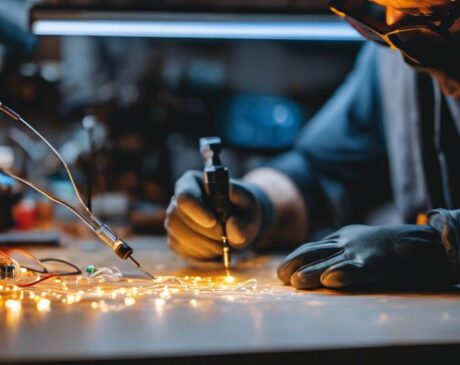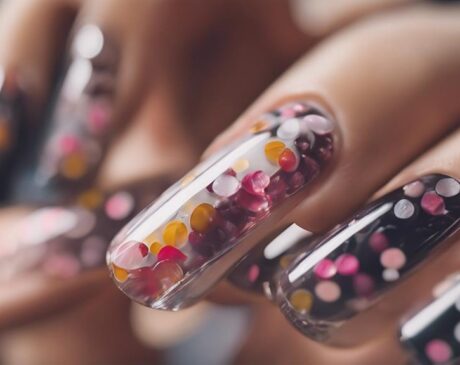How long can you leave glue on nails?

Glued nails have become a staple in the beauty and nail care sector, offering a quick and easy solution for a polished look without the time and expense. These artificial nails are adhered to natural nails using a specific type of glue and come in a variety of shapes, sizes, and designs that cater to different aesthetic preferences.
Understanding glue on nails
Composition and Types
Glue nails are usually made of acrylic resin, a plastic material known for its durability and flexibility. They come in a variety of types, such as full-coverage nails that cover the entire surface of the nail and tips that extend the length of the natural nail. Each type is designed to mimic the look of professionally manicured nails, offering a wide range of options from natural-looking to sophisticated designs.
Application Process
The application process for Glue Nails involves several steps. First, natural nails are cleaned and buffed to create a smooth surface. Then, a small amount of specialized nail glue is applied to the artificial nail or directly to the natural nail. The glue nail is then firmly pressed onto the natural nail to ensure it is properly aligned and secured.
Factors affecting the life of nail glue
Quality of the glue nail
The durability of glue nails depends greatly on the quality of the nail glue used. High-quality glue provides stronger adhesion and longer wear, reducing the likelihood of premature nail removal.
Nail Preparation and Application Techniques
Proper nail preparation, including thorough cleaning and buffing, is essential for enhanced adhesion. In addition, techniques used during application, such as applying the right amount of glue and avoiding air bubbles, play a key role in the longevity of nails.
Daily activities and nail care
Daily activities can affect the longevity of glue nails. Exposure to water, harsh chemicals, and physical activities can weaken the bond. Taking precautions, such as wearing gloves when cleaning and treating nails gently, can extend their wear time.
Recommended timeframe for applying glue to nails
General Guidelines
Generally, glue nails can be safely worn for about 1-2 weeks. This duration ensures that the natural nail underneath remains healthy and is not subjected to prolonged stress.
Signs that it’s time to remove them
It’s important to look out for signs that indicate it’s time to remove your glued nails, such as raised edges, visible growth at the base, or any discomfort. Removing them at the right time will help prevent damage to your natural nails.
Risks of prolonged wear
Wearing glued nails for extended periods of time can pose risks to the health and well-being of your natural nails. Understanding these risks is essential to maintaining healthy nails under glamor.
Nail Health Problems
Wearing glue nails for long periods of time can lead to a number of nail health issues. The lack of air and moisture in natural nails can cause them to become weak, brittle, and dry. Additionally, the constant pressure and weight of artificial nails can hinder natural nail growth and lead to thinning of the nail plate.
Potential Damage and Infection
There is also a risk of damage and infection. The glue used to bond these nails can sometimes be rough and can cause damage to the natural nail surface. Additionally, if water or bacteria are trapped between the natural and artificial nails, this can lead to fungal or bacterial infections that require medical attention.
Properly Remove Glue from Nails
Properly removing glue nails is critical to preventing damage to your natural nails. Below is a step-by-step guide on how to perform this procedure safely:
Step-by-Step Guide
- Soak Nails: First soak your nails in warm soapy water for about 10-15 minutes. This will help loosen the glue.
- Gently pry the edges: Using a wooden cuticle stick, gently pry the edges of the glued nail. If the nail doesn’t come off easily, soak it for a few more minutes.
- Use a nail polish remover: For stubborn glue, use an acetone-based nail polish remover. Apply it to the edges and underneath the nail, then gently pry it off.
- Avoid applying pressure: Never apply pressure to remove your nails as this may strip your natural nails.
Post-care tips for natural nails
After removing glue nails, it is important to care for your natural nails:
- Moisturize: apply nourishing nail polish or moisturizer to restore moisture.
- Trim and file: trim any damaged edges and gently file your nails.
- Take a break: allow your nails some time to breathe and recover before using another set of artificial nails.
Tips for Extending the Life of Glue Nails
To extend the life of your glue nails and maintain their appearance, follow these tips:
Maintenance Tips
- Avoid contact with water: minimize the amount of time your nails are submerged in water.
- Wear gloves: Wear gloves when cleaning or washing dishes.
- Use gently: Pay attention to how you use your nails to prevent them from buckling or breaking.
Recommended Products
Investing in quality products can also make a difference:
- Quality Nail Glue: Choose a premium adhesive for a better bond.
- Top Coat: Apply a clear top coat every few days to maintain shine and protect the design.
Alternatives to Nail Glue
If you’re looking for less destructive or manageable alternatives to glue nails, consider the following options:
Pressed Nails
Pressed nails are a great alternative. They are easier to apply and remove and are usually less damaging to your natural nails.
Professional Acrylics and Gels
Visiting a professional for acrylic or gel nails may be a safer option. When applied and removed correctly, these options can be less harmful and provide longer-lasting results.
In conclusion, gel nails offer a convenient and versatile way to achieve a salon-like, beautiful manicure at home. However, it is important to understand their ingredients, the application process, and the factors that affect their longevity to ensure the best results. Wearing glue nails for extended periods of time can pose risks such as nail damage and infection, so proper removal and aftercare are crucial to keeping your natural nails healthy.
Balancing beauty and nail health is key. By understanding the risks, following the recommended wearing timeframes, and utilizing proper maintenance and removal techniques, you can enjoy the aesthetic benefits of glue nails without compromising the health of your natural nails. For those looking for a different solution, alternative options such as press-on nails, acrylics, or gels by a professional can also be considered.
Frequently Asked Questions
- How often should I change the glue on my nails?
- Glued nails should ideally be replaced every 1-2 weeks. This frequency helps maintain aesthetic appeal while minimizing the risk of damage to your natural nails.
- Will wearing glue on my nails continue to damage my natural nails?
- Yes, wearing glue nails consistently will cause your natural nails to weaken, become brittle and dry out. It can also lead to thinning of the nail plate and increase the risk of fungal or bacterial infections.
- What are the signs that I need to remove glue from my nails?
- Signs that indicate the need for removal include warped edges, visible growth at the root of the nail, discoloration, and any discomfort or pain. Removing the glue from the nail at these signs will help prevent potential damage.
- Is it safe to apply glue to nails at home?
- If done correctly, applying glue nails at home is usually safe. Make sure your natural nails are clean and dry, apply glue carefully, and avoid excessive force or pressure. Following proper application and removal guidelines is the key to safety.
- How can I extend the life of my nail glue while keeping my nails healthy?
- To extend their lifespan, minimize contact with water, use gloves when doing chores, apply a top coat every few days, and choose a quality adhesive product. Remember, even with these precautions, it’s important to give your natural nails a break between uses to keep them healthy.




